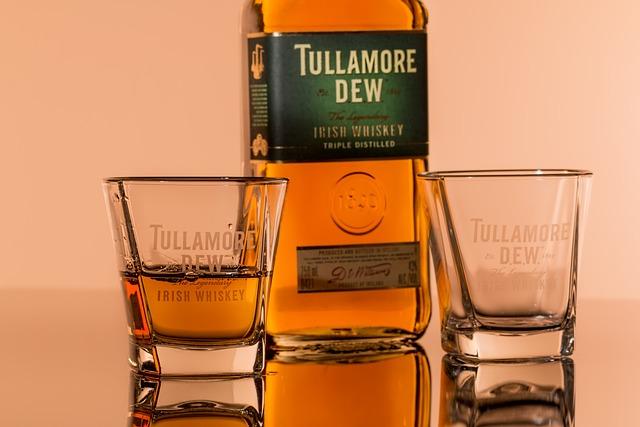Bottles and Barrels: Unveiling Whiskey’s Math

Many of us enjoy sipping on a glass of whiskey, savoring the rich flavors and complex aromas that dance across our palates. But have you ever stopped to think about the math behind the whiskey-making process? From the size and shape of the bottles to the aging in barrels, there’s a fascinating world of numbers and calculations that goes into creating that perfect pour. Join me as we unravel the mysteries of whiskey’s math, exploring how these elements come together to create the liquid gold we love to drink.
The Role of Wood Aging in Whiskey Flavor Development
There is an intricate dance that takes place between wood aging and whiskey flavor development, a delicate balance that can make or break the final product. The journey of whiskey from distillation to aging in barrels is where magic truly happens, unlocking a symphony of aromas and tastes that captivate the senses.
**The Role of Wood in Whiskey Flavor Development:**
- Wood provides the whiskey with its distinct color, flavor, and aroma.
- During aging, whiskey interacts with the wood, extracting compounds that contribute to its complexity.
- The type of wood, level of char, and length of aging all play crucial roles in shaping the final flavor profile of the whiskey.
**Unlocking the Secrets of Wood Aging:**
| Wood Type | Char Level | Age |
|---|---|---|
| American Oak | Medium | 12 years |
| French Oak | Heavy | 8 years |
| Japanese Mizunara Oak | Light | 18 years |
Each wood type brings its own unique characteristics to the whiskey, creating a tapestry of flavors that evolve over time. From oak vanillin to caramelized sugars, the influence of wood aging is undeniable in shaping the complexity and depth of whiskey’s flavor profile.
Understanding the Influence of Barrel Size on Whiskey Maturation
When it comes to whiskey maturation, the size of the barrel plays a crucial role in determining the final flavor profile of the spirit. Barrel size can impact various aspects of the aging process, influencing everything from the rate of oxidation to the extraction of compounds from the wood. Understanding how different barrel sizes affect whiskey maturation is key to producing a high-quality product.
**Key Factors to Consider:**
- The Surface Area to Volume Ratio: Smaller barrels have a higher surface area to volume ratio, allowing for more rapid interaction between the whiskey and the wood.
- Oak Influence: Larger barrels tend to impart more subtle oak flavors, while smaller barrels can lead to more pronounced wood characteristics.
- Aging Time: Whiskey aged in smaller barrels may mature more quickly due to increased wood contact, whereas whiskey aged in larger barrels may require more time to develop complex flavors.
| Barrel Size | Impact on Maturation |
|---|---|
| Small | Intensifies flavors, accelerates aging process |
| Large | Produces more mellow, subtle flavors, slower aging process |
Exploring the Impact of Climate on Whiskey Aging
When it comes to the world of whiskey, one of the most fascinating aspects is how climate can greatly influence the aging process. The combination of temperature, humidity, and air quality can have a profound impact on the flavors and aromas that develop within a bottle of whiskey over time. Understanding this relationship between climate and whiskey aging is crucial for distillers seeking to produce high-quality spirits.
**Factors to Consider:**
- Temperature: Fluctuations in temperature can cause the whiskey to expand and contract within the barrel, allowing it to interact with the wood and extract flavor compounds.
- Humidity: Higher humidity levels can slow down evaporation, while lower humidity levels can intensify the aging process.
- Air Quality: The presence of oxygen in the barrel can help mature the whiskey, while excessive exposure to air can lead to oxidation and spoilage.
**Climate Study Findings:**
| Location | Temperature Range | Humidity Level |
|---|---|---|
| Scotland | 40-60°F | 70-80% |
| Kentucky | 80-90°F | 60-70% |
By examining the specific climate conditions in different whiskey-producing regions, distillers can fine-tune their aging processes to achieve the desired flavor profiles in their spirits. The art of whiskey-making truly is a delicate balance of science and nature, with climate playing a significant role in the final product that ends up in your glass.
Analyzing the Importance of Distillation Techniques in Whiskey Production
When it comes to producing whiskey, the distillation process plays a crucial role in creating that perfect bottle of liquid gold. Understanding the importance of distillation techniques is like uncovering the secret formula behind your favorite whiskey’s unique taste and aroma.
Using a combination of pot stills and column stills, distillers are able to precisely control the distillation process to extract the desired flavors and aromas from the raw ingredients. This intricate dance of heat, vapor, and condensation is what transforms a simple mash into a complex and nuanced spirit.
By carefully analyzing the distillation techniques used in whiskey production, we can gain a deeper appreciation for the craftsmanship and artistry that goes into each bottle. From the type of stills used to the number of distillation runs, every decision made during the distillation process can have a significant impact on the final product. So the next time you pour yourself a glass of whiskey, take a moment to savor not just the taste, but also the math and science that went into creating that perfect sip.
Unveiling the Chemistry Behind Whiskey Distilling
Understanding the chemistry behind whiskey distilling is like unraveling a complex yet fascinating puzzle that involves a delicate balance of ingredients, processes, and time. At the heart of this alchemy lies the interaction between water, grain, yeast, and wood, which all play a crucial role in shaping the unique characteristics of each bottle of whiskey.
Let’s break down the key components involved:
- Water: The quality and mineral content of water used in distillation can greatly influence the final flavor profile of whiskey.
- Grain: Different types of grains, such as barley, corn, rye, and wheat, provide the sugars necessary for fermentation, which ultimately impacts the taste and mouthfeel of the spirit.
- Yeast: Yeast is responsible for converting sugar into alcohol during fermentation, contributing to the aroma and flavor complexity of the whiskey.
- Wood: Aging whiskey in barrels made of oak imparts additional flavors and characteristics, such as vanilla, caramel, and spices, through the process of maturation.
Comparing Single Barrel vs. Small Batch Whiskey Production Methods
When it comes to whiskey production, there are two main methods that distillers use: single barrel and small batch. Each method has its own unique characteristics that contribute to the flavor profile of the final product.
With single barrel whiskey production, each bottle is filled from a single aging barrel. This means that each bottle is unique and may vary in flavor slightly from bottle to bottle. The aging process is typically longer for single barrel whiskeys, allowing for more complex flavors to develop.
On the other hand, small batch whiskey production involves blending the contents of a small number of barrels to create a consistent flavor profile. This method allows for more control over the final product and can result in a smoother, more balanced whiskey.
Mastering the Art of Blending Whiskey for Complex Flavors
When it comes to creating the perfect blend of whiskey, it’s all about understanding the art of mixing different flavors and aromas together. Whiskey blending involves a delicate balance of science and creativity, where each component plays a crucial role in the final product. By mastering the art of blending, you can create complex and unique flavors that stand out from the rest.
One key aspect of whiskey blending is the use of different types of barrels, each adding its own distinct characteristics to the final blend. Whether it’s a charred oak barrel for aging or a sherry cask for finishing, the choice of barrel can greatly influence the flavor profile of the whiskey. Experimenting with different barrel combinations can lead to exciting new flavor discoveries.
Another important factor in whiskey blending is the math behind it all. Understanding the precise measurements of each component, from the base spirit to the aging whiskies, is crucial for achieving consistency and balance in the final blend. By honing your math skills and experimenting with different ratios, you can create a whiskey blend that is truly unique and full of complexity.
Unlocking the Secrets of Whiskey’s Proof and Alcohol by Volume
In the world of whiskey, the terms “proof” and “alcohol by volume” are essential components of understanding the strength and intensity of your favorite spirit. While these terms may seem like mysterious numbers to the uninitiated, they actually reveal a fascinating insight into the craftsmanship behind each bottle.
When it comes to whiskey’s proof, we’re talking about the alcohol content of the spirit. The proof is essentially double the alcohol by volume (ABV) percentage, making it a simple way to determine the strength of the drink. For example, a whiskey with 50% ABV would be 100 proof. Understanding this math can help you choose the right whiskey for your palate or mixing needs.
Next time you pour yourself a glass of whiskey, take a moment to appreciate the math and science behind the proof and alcohol by volume. By unlocking these secrets, you’ll gain a deeper appreciation for the skill and precision that goes into crafting each bottle of this beloved spirit.
Deciphering the Labeling Regulations for Whiskey Bottles
When it comes to , there’s more than meets the eye. From understanding the proof and aging requirements to knowing the difference between blended and single malt, navigating the world of whiskey can be a complex endeavor. But fear not, we’re here to break it down for you.
One of the key elements to look out for when reading a whiskey label is the proof. This number represents the alcohol content of the whiskey and is typically listed as a percentage. For example, a whiskey that is 80 proof contains 40% alcohol. Knowing the proof of your whiskey can help you gauge its strength and flavor profile.
Another important aspect to consider is the aging statement. This indicates how long the whiskey has been aged in barrels before bottling. For instance, a whiskey labeled as “10-year-old” has been aged for a decade. The aging process imparts flavors and characteristics to the whiskey, making it an essential factor in determining its quality and taste.
Enhancing Your Whiskey Tasting Experience: Expert Tips and Tricks
When it comes to enhancing your whiskey tasting experience, understanding the math behind bottles and barrels can truly elevate your palate. Did you know that the size of a barrel can impact the flavor of the whiskey? Smaller barrels have a higher surface area to volume ratio, leading to faster aging and a more intense flavor profile. On the other hand, larger barrels result in a slower aging process and a smoother taste.
Another interesting fact is that whiskey gains proof as it ages in the barrel. This is due to the angel’s share, or the portion of whiskey that evaporates during maturation. As a result, older whiskeys tend to have a higher alcohol content. Understanding these nuances can help you appreciate the craftsmanship that goes into each bottle.
For a fun experiment, try tasting whiskeys aged in different barrel sizes side by side. Take note of the flavors and aromas unique to each aging process. By delving into the math behind whiskey production, you’ll gain a deeper appreciation for the artistry and science that goes into crafting this beloved spirit.
In conclusion, understanding the mathematical intricacies behind whiskey production can enhance our appreciation for this timeless spirit. From the exacting measurements of barrels to the precise blending ratios of bottles, every step in the process plays a vital role in creating the unique flavors we enjoy. So next time you raise a glass of whiskey, take a moment to toast to the precision and expertise that goes into every pour. Cheers to the math behind the magic!















